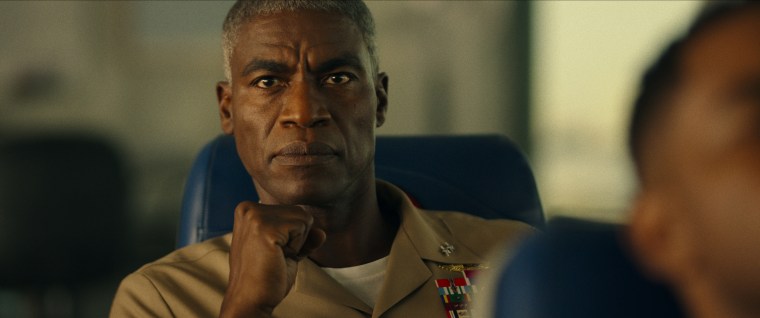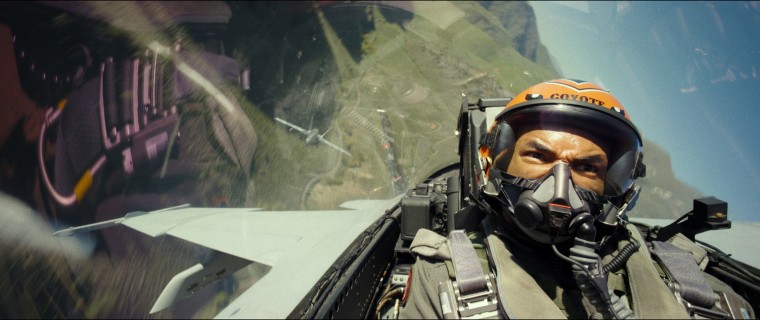By Arturo Conde
Actor Jay Ellis remembers watching the 1986 movie “Top Gun” at an Air Force base in Austin, Texas. He was only 8 or 9 years old, and the blockbuster made him dream about becoming a fighter pilot. Ellis wanted to be part of that military community.
Now, he plays Navy fighter pilot Payback in the anticipated sequel “Top Gun: Maverick,” which releases nationwide Friday and in select theaters starting Tuesday. He said he sees the film as a way to say thank you to the real men and women who inspired him as a boy.
“I grew up around aviation, and I think about the sacrifice that so many men and women take — they give, rather — just for us to be safe,” he said. “I think we all wrap our arms around this community and we protect it so much. And we understand the responsibility to be amazing on-screen for these folks.”
Both of Ellis’ grandfathers, his step-grandfather and his father were in the Air Force, so telling the story about a community of aviators is important to him. He said he thinks the first “Top Gun” was a worldwide success because few people knew about Navy pilots.
“I think seeing yourself on-screen always is something that people lean into,” he said. “We knew that people flew in jets and protected this country in that way. But we didn’t know the ways in which they get chosen and how they trained to do it.”
Thirty-six years later, the sequel aims to continue that story, drawing fans back in with Tom Cruise reprising his role as Maverick.
In “Top Gun: Maverick,” he returns to the naval flight academy to train a new class of pilots. One of those pilots is Rooster (Miles Teller), the son of Maverick’s former wingman, Goose (Anthony Edwards), who died in the first film after ejecting from an F-14 plane.
Representation on screen and in history
Actor Greg Tarzan Davis, who plays the fighter pilot Coyote in the sequel, said he hopes this film will inspire a new generation of viewers. He said showing a Black Navy pilot with other diverse pilots on the big screen is an important milestone.
“When I saw the first ‘Top Gun,’ obviously there was one Black character, Sundown, but I don’t think he was represented as fully as he could have been,” he said. “So I think that it’s really cool that we have the representation, not just of Black characters, but of many different men and women.”
While Black people have been involved in the U.S. military since its earliest stages, the combat roles portrayed in the film were not available to Black Americans until recent decades.
“The Navy, like all American services, was very resistant to having Black Americans in any position that was oriented towards combat and wanted to keep them in service positions like mess hall attendants,” military historian David Silbey said.
Silbey pointed out that the racial stereotyping of Black people and other nonwhite groups in the military also hindered their paths to equality in civilian life.
“The idea that they were not able to handle the responsibility of combat has a political implication,” he said. “When you relegate nonwhite people from specially valorous positions, you are implicitly undercutting any political claim they could have later on.”
The Navy’s first decorated Black service member was Doris Miller, a mess attendant aboard the USS West Virginia, which was anchored at Pearl Harbor during the attack by the Japanese in 1941. He carried wounded sailors from the ship to safety and then manned an anti-aircraft gun, shooting at the attacking planes until he was forced to abandon ship. He had never received any training for that type of combat.
“His job was to serve food to officers. He wasn’t supposed to be in a combat position,” Silbey said. “In spite of his bravery, Miller doesn’t get the medal honor,” the highest award for military valor, “but the Navy Cross.”
He was killed two years later aboard the USS Liscome Bay when a torpedo hit the ship.
In 1948, following World War II, President Harry Truman signed an executive order ending racial segregation in the armed services.
Silbey said while showing a diverse Navy community on film is important, viewers also need to acknowledge the wider history and ongoing challenges of race in the military.
“The military may be better than a lot of institutions in American life and is actually pretty good now in integrating a range of diverse communities,” he said. “I think it’s a reasonably fair portrayal, but we need to recognize that there’s still a long way to go for the armed services and American society as a whole.”
Playing a naval officer on the big screen
Actor Charles Parnell has played different military characters. Fans will recognize him as Master Chief Petty Officer Russell Jeter on the action-drama TV series “The Last Ship.” In “Top Gun: Maverick,” he has been promoted to Rear Adm. Solomon “Warlock” Bates.

Off-screen, Parnell said many of his friends had coincidentally enlisted in the Navy. He said he took their advice for wearing his uniform in the film and carrying himself as an officer to portray his character with authenticity. He said this experience has also given him a deeper admiration for the Navy.
“I really just learned commitment and responsibility from them in a way that I hadn’t thought about it before,” Parnell said. “And translating that into playing a character on-screen representing a diverse ethnicity just gave me more pride in being a Black man in that position.”
The first Black Navy officer to serve aboard a fighting ship was Samuel Lee Gravely Jr. He was promoted to rear admiral in 1971, at a time when Black members still faced widespread discrimination in the Navy.
Just one year later, The New York Times reported that Adm. Elmo Zumwalt, chief of naval operations, rebuked the Navy’s high command for failing to take action against racial discrimination.
On-screen, Parnell’s character acts as the go-between for Vice Adm. Beau “Cyclone” Simpson (Jon Hamm) and Cruise’s Maverick. In some ways, his character could represent many Black men and women who have served as intermediaries between American society and the Navy on a path to equality.
When asked about the call sign Warlock given to his character in “Top Gun: Maverick,” Parnell said he came up with his own explanation.
“I think that character was in the original ‘Top Gun,’ and he flew with that class. But every time you see a photo, he’s just on the outside of the photo, so you can’t see him,” he said. “My name, Warlock, to me means I managed to disappear out of all of the pictures in the old film. So that’s why they call me Warlock, ’cause I could mysteriously evaporate.”

